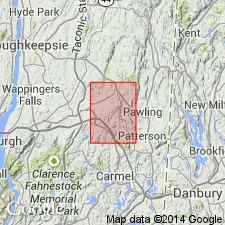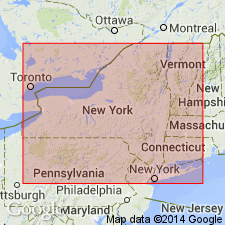
- Usage in publication:
-
- Pine Plains Formation*
- Modifications:
-
- Revised
- Age modified
- AAPG geologic province:
-
- New England province
Summary:
Pine Plains Formation is here assigned to the Wappinger Group. Age is changed from Late Cambrian to Middle(?) and Late Cambrian, based on Knopf, E. B., 1962, Stratigraphy and structure of the Stissing Mountain area, Dutchess Co., New York: Stanford Univ. Pubs. in Geol. Sci., v. 7, no. 1, p. 24-26. Overlies Stissing Dolomite and underlies Briarcliff Dolomite.
Source: GNU records (USGS DDS-6; Reston GNULEX).

- Usage in publication:
-
- Pine Plains Formation
- Modifications:
-
- Overview
- Age modified
- AAPG geologic province:
-
- New England province
Summary:
The dolostones of the Pine Plains Formation of the Wappinger Group of southeastern NY were deposited in a peritidal setting. Outside the type locality, the unit extends to the Upper Ordovician. Unit displays variety of textures and structures including, cryptalgal and domal stromatolites, birdseye textures, stylolites, crystal- and biomolds, healed fractures, cross-stratification, geodes, scour and fill structures, and oolitic textures.
Source: GNU records (USGS DDS-6; Reston GNULEX).
For more information, please contact Nancy Stamm, Geologic Names Committee Secretary.
Asterisk (*) indicates published by U.S. Geological Survey authors.
"No current usage" (†) implies that a name has been abandoned or has fallen into disuse. Former usage and, if known, replacement name given in parentheses ( ).
Slash (/) indicates name conflicts with nomenclatural guidelines (CSN, 1933; ACSN, 1961, 1970; NACSN, 1983, 2005, 2021). May be explained within brackets ([ ]).

